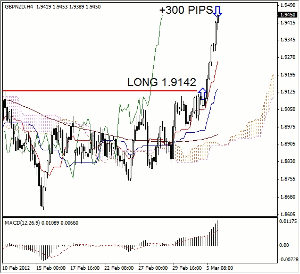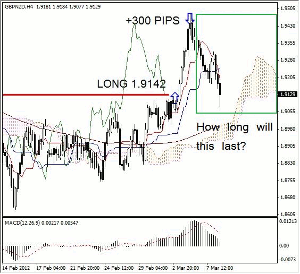Balancing risk vs. reward is one of the cornerstones of successful trading, and in this article, forex trader Mike Kulej of FXMadness.com reviews a recent trade to illustrate how he arrived at his decision.
One of the most important parts of trading, often overlooked, is taking profits. Everybody focuses on entries, set ups, devoting a lot of time to create “perfect strategy,” yet at the same time rules for taking profits are often left to chance. Frankly, this is very understandable. Trading is an emotional endeavor, like it or not. Having a trade in positive territory creates very pleasant sensation. These feelings, like elation and excitement can be as powerful, if not more so, as disappointment and discouragement when taking a loss. In fact, for many traders taking a loss becomes a fact of life and is relatively easy to accept. One admits, “OK, I made a mistake, market proved me wrong. Moving on.” Appropriate note is made in a trading journal and search for next trade is under way. Taking profits is a little different.
When trade moves our way, we always hope it is going to progress even more. We try to squeeze every possible pip out of the market, which is only natural. After all, most of us are in the market to make money, not because we are in need of mental challenge. For that, one can play chess or try to decipher writings of Nostradamus. Unfortunately, this amounts to finding a top/bottom, in order to fully monetize trade, which is exceedingly hard to do. This typically creates situations when a transaction, after being profitable for some time, sheds gains and even turns negative. Very unpleasant feeling, yet one that everybody is familiar with. One starts to question own ability as a trader often leading to self-doubt and undermining entire enterprise.
What to do, then? There is no simple answer, but for most traders setting targets for trades should be as important as the entry set-ups themselves. If market reaches projected value, in most cases trade should be closed and profits pocketed. It worked as planned; objective was met on correct analysis, job well done. And yes, very often the moves will continue, making us feel as if we left “money on the table.” While this is certainly strong emotion, it is not nearly as debilitating as the ones mentioned before. A trader’s job is not necessarily to be great predictor of things, or not even to be right, but to make money on those occasions when we are right. Give it some thought.
NEXT PAGE: Time Before Profits |pagebreak|
There are strategies that employ trailing stops, without having objectives. All methods that rely on crossovers of indicators and oscillators fall into this category. In addition, tracking market progress with stops just under/above most recent bottoms/tops is like that. I employ some of these methods form time to time. Strategies like that will not capture the entire move, something that must be accepted before even starting to trade one. The nature of these kinds of methods is such that many trades will end in small gains and losses, but few will deliver huge moves, hopefully making more money than losing. Trading like this is absolutely OK, as long as rules are observed. One just must be aware of limitations.
What about if trade is going along fine, but is short of the objective? Should it be closed, because of the emergence of negative market news? What if our opinion changes? What if the trade takes too long? What if….? There is no one straight, fit-all answer to this. Trading is an enterprise involving many variables, constantly shifting elements. Some of them can be categorized, while others demand discretion, which gets better with experience. This week I made such decision in a trade that was featured on these pages.
On Sunday, I discussed the possibility of bullish reversals in the GBP/NZD and the GBP/AUD. Both of them looked very similar, approaching likely breakout levels. Because the GBP/NZD was the first to breach its resistance, that was the trade I took. I estimated the potential here to be as much as perhaps 1,000 pips, yet I closed the trade for only 300 pips gain. Why? For a simple reason—time.Because this particular set-up developed on the intermediate-term chart, reasonable expectation for the trade to achieve its full potential is measured in weeks. Chances of a corrective move of consolidation during such a long time span are high. Am I willing to sit through it or should I pocket smaller gains if they happen fast? Since I was in the black 300 pips within one day, I decided to take these pips.
Admittedly, there was element of luck involved, because the rally continued only for another 50 pips before the current correction kicked in. However, this is precisely what I was trying to avoid. Even though I still think the GBP/NZD will go higher, there is no telling when. Of course, it does not always work out so well, but on longer-term charts, it makes sense to me to forgo some profits for the benefit of time.
By Mike Kulej of FXMadness.com























